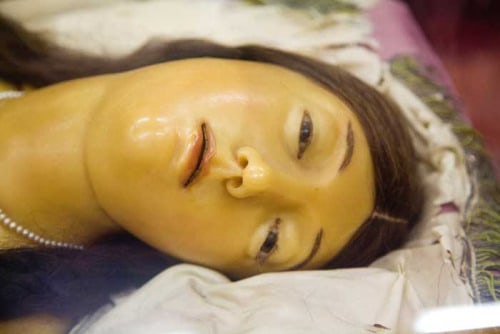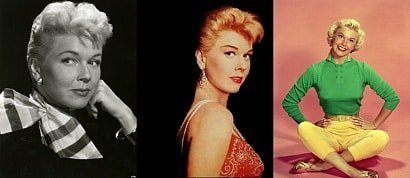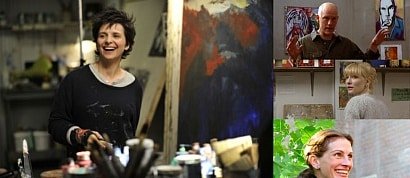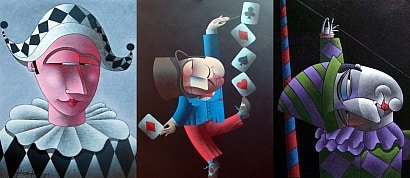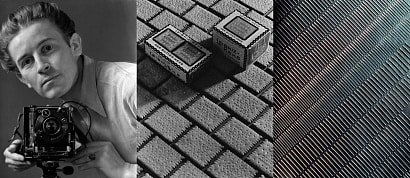Anatomical Models
 Add image to section
Add image to section
Venus by Clemente Susini
Created between 1780 and 1782, the original anatomical Venus by Clemente Susini (pictured) can still be seen at La Specola – the public science museum founded by Leopold II in Florence. Also known as ‘the Medici Venus’, the life-size wax figure has real human hair, and can be dissected into seven anatomically correct layers. She spawned numerous copies, referred to as Slashed Beauties or Dissected Graces and also displayed in medical museums. “Supine in their glass boxes, they beckon with a gentle smile or an ecstatic downcast gaze,” writes Ebenstein in The Anatomical Venus. “One idly toys with a plait of real golden human hair; another clutches at the plush, moth-eaten satin cushions of her case as her torso erupts in a spontaneous, bloodless auto-dissection; another is crowned with a golden tiara, while one further wears a silk ribbon tied in a bow around a dangling entrail.”
 Add image to section
Add image to section
The “Venerina” or “Little Venus” anatomical model
The “Venerina” or “Little Venus” anatomical model by Clemente Susini, 1782, as seen at the Palazzo Poggi in Bologna, Italy. Photo by Joanna Ebenstein, Morbid Anatomy.
 Add image to section
Add image to section
Philippe Curtius' Sleeping Beauty
This figure is known as ‘the Sleeping Beauty’: a 1925 replica of the original piece from 1767, it’s a breathing wax model by Swiss physician and master wax sculptor Philippe Curtius. (Credit: Madame Tussauds Archives, London. Photo Joanna Ebenstein)
 Add image to section
Add image to section
Collection’s Anatomical Venus
Joanna Ebenstein claims, “the Medici Venus was a perfect embodiment of the Enlightenment values of her time, in which human anatomy was understood as a reflection of the world and the pinnacle of divine knowledge, and in which to know the human body was to know the mind of God.”
However uncanny they might seem to us, the wax figures were primarily teaching tools. According to Ebenstein, “Each pristine wax model at the museum was the product of the careful study of cadavers that were delivered from the nearby Santa Maria Nuova hospital.” They remain close to life. “Over 200 years after their creation, La Specola’s waxworks are still considered remarkably accurate, some of them demonstrating anatomical structures that had yet to be named or described at the time of their making.” Yet in making them more attractive than a cadaver, the waxwork sculptors were also creating art works. As Ebenstein argues, the anatomical Venus evoked “a long history of paintings and sculptures of placid, idealised nudes”. And that’s where the human detail that unnerves us came in. “She is designed to charm in every detail: her glistening glass eyes are rimmed with real eye-lashes, her bared throat is bound by a string of pearls, and she boasts a lustrous cascade of human hair.”
However uncanny they might seem to us, the wax figures were primarily teaching tools. According to Ebenstein, “Each pristine wax model at the museum was the product of the careful study of cadavers that were delivered from the nearby Santa Maria Nuova hospital.” They remain close to life. “Over 200 years after their creation, La Specola’s waxworks are still considered remarkably accurate, some of them demonstrating anatomical structures that had yet to be named or described at the time of their making.” Yet in making them more attractive than a cadaver, the waxwork sculptors were also creating art works. As Ebenstein argues, the anatomical Venus evoked “a long history of paintings and sculptures of placid, idealised nudes”. And that’s where the human detail that unnerves us came in. “She is designed to charm in every detail: her glistening glass eyes are rimmed with real eye-lashes, her bared throat is bound by a string of pearls, and she boasts a lustrous cascade of human hair.”
Added to
People who voted for this also voted for
British Drama: Jake's Progress
Tiere in Nebenrollen
Beauty and the Cutie
Irish History On Display At Dublin's National Gall
British Mystery: A Touch of Frost
Lists by Other Members That Made Me Feel Nostalgic
Animals and Ice Cubes
Angel Faces 4
Perfectly Camouflaged Animals #1
Baku- Azerbaijan
Brown Eyed Beauties
«blond, i hope it doesn't extinct»
Remembering Doris Day
Newspapers, 2
Licence Renewed (2004)
More lists from Nusch
PHOTOS | Luiz Braga
Art teachers
PHOTOS | Gorm Valentin
ART | Lima Junior
PHOTOS | Hein Gorny
Suicide Scenes
Nietzsche in Film
 Login
Login
